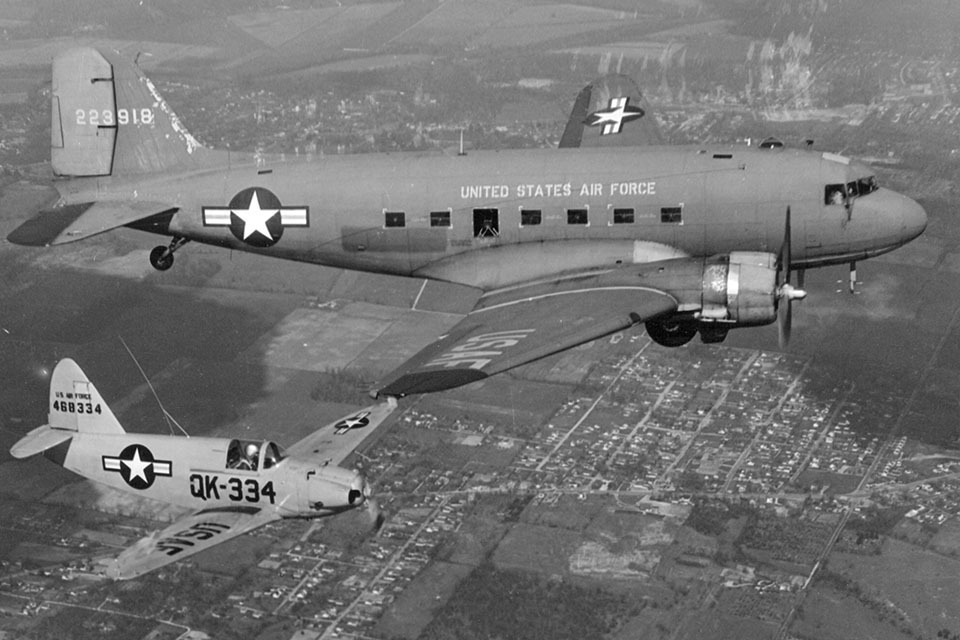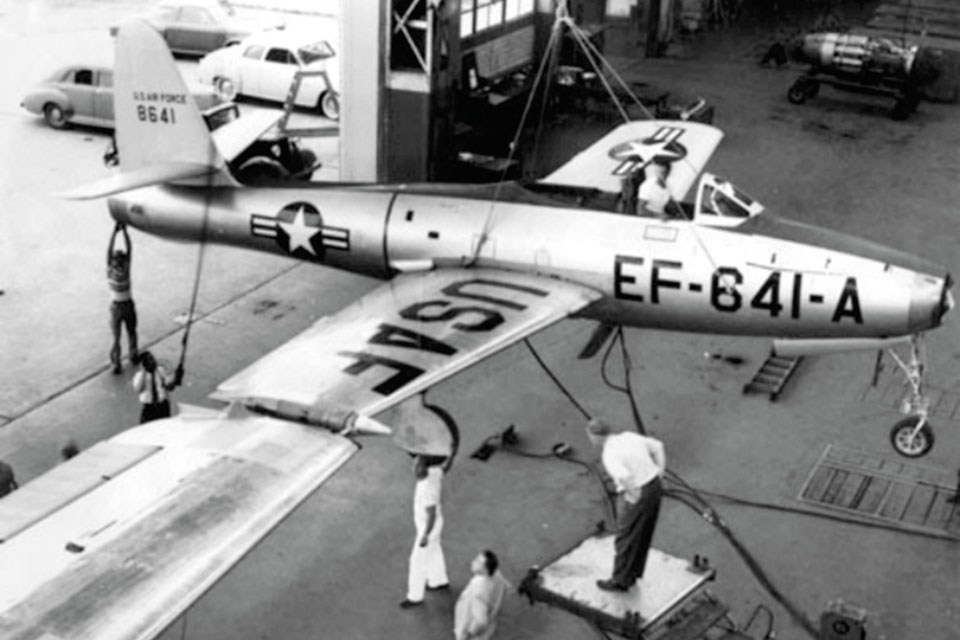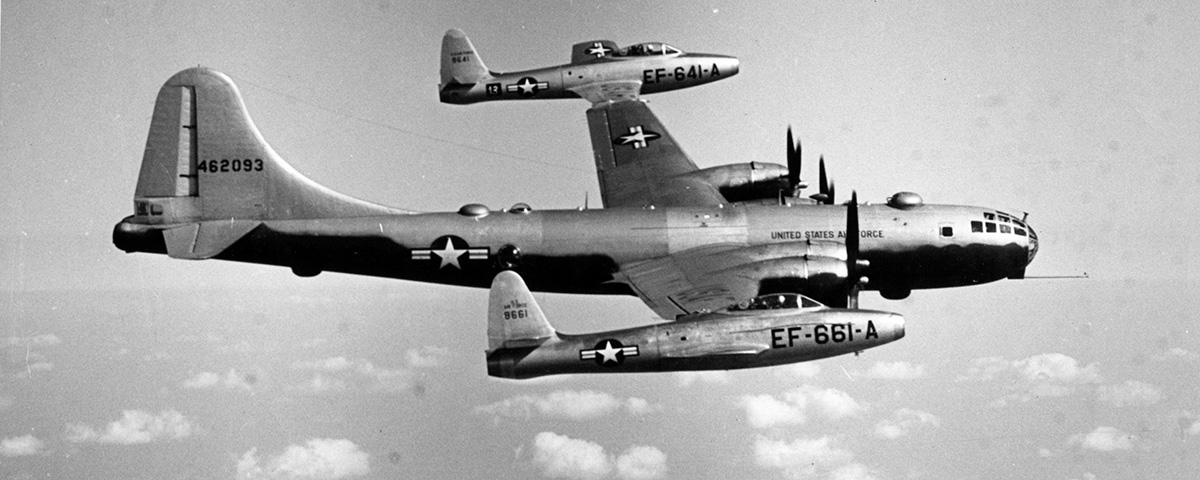The history of aviation is full of ideas that seemed ingenious when first pro- posed but failed in practice. These notions are usually born out of an attempt to overcome vexing limitations of range, performance, speed or other parameters through a clever shortcut or gimmick. Once in a while such things actually work— up to a point, when it becomes clear that maybe they weren’t such great ideas after all.
One of the best examples of this phenomenon was Project Tip-Tow, a Cold War concept to increase the effective combat radius of jet fighters by attaching them to a propdriven bomber, one hooked up to each wingtip. The hope was that it would not only increase fuel efficiency and effective range, but also allow the bomber to carry its own fighter escort deep into enemy territory. It was a beautiful idea—in theory.
The “floating wingtip” idea from which Project Tip-Tow evolved had originally been developed by Richard Vogt, a German aeronautical engineer known for unusual, off-the-wall concepts. Vogt’s idea was a way of having one’s aerodynamic cake and eating it too: By extending the overall aspect ratio of an airplane’s wing, floating wing panels would add lift and improve aerodynamic efficiency, and could carry extra fuel. Yet because they wouldn’t be firmly attached to the aircraft structure and would support themselves by aerodynamic lift, the panels wouldn’t increase wing loading. Theoretically, Vogt’s concept could be extended beyond floating wing panels to encompass entire aircraft serving as “wing extensions.”
Vogt had conducted rudimentary experiments on the concept during 1944 and 1945, but the work went nowhere, probably because the Luftwaffe had more pressing concerns at the time. When Vogt came to America after the war, the U.S. Air Force greeted his idea with more enthusiasm. In those days before intercontinental jet bombers, when the USAF faced a potential adversary on the other side of the planet, any proposal to extend the range and endurance of its strategic air arm was more than welcome.
In 1949 small-scale experiments were undertaken at Wright Field in Ohio using a Douglas C-47A and a Culver Q-14B, just to test the feasibility of the idea before trying it with full-scale bomber and fighter aircraft. The hookup apparatus was simplicity itself: Attached to the C-47 wingtip was a small ring, its opening facing forward; on the Q-14 was a short, backward-facing lance. The Q-14 pilot would simply maneuver the lance to hook up with the ring. No locking mechanism was needed, since the drag of the planes moving forward through the airstream would automatically keep the lance inside the ring. To uncouple, the Q-14 pilot merely had to increase his airspeed a bit until the lance was out of the ring, then move away.

After some initial difficulties caused by strong wingtip vortex airflows, the receiver ring was moved slightly farther out from the wingtip. The first successful coupling was made on October 7, 1949, with Major Clarence “Bud” Anderson flying the Q-14.
Over the following months, many more coupling flights were made under various conditions, even at night, enough to prove to the Air Force brass that the concept might just work. The next step was to scale it up to operational level, with a Boeing ETB-29A bomber and two Republic EF-84D Thunderjets. The Air Force awarded Republic Aviation a contract to undertake Project Tip-Tow (so named because the fighters were towed on the wingtips) in 1950. Tests would be conducted at Republic’s Long Island headquarters.
For Tip-Tow, the coupling mechanism was considerably more complicated. Instead of being loosely joined in an easily broken connection, the aircraft would now be firmly attached by the wingtips. To hook up, a short hydraulically controlled boom would be extended from the B-29 wingtip, with a receptacle on the end. The F-84’s wingtip carried a small forward-pointing lance that fitted into the boom receptacle. Once the lance was snugly fitted inside the receptacle, the boom was retracted, drawing the wingtips together until they made contact, when a pin mechanism in the B-29 wingtip engaged to lock the two wingtips together. A rubber seal on the B-29 wingtip ensured an airtight connection. The Thunderjet could still maneuver in pitch, roll and yaw until the wingtips were fully locked, at which time its movements were restricted to the roll axis of the wingtip connection.
Despite the greater complexity of this arrangement compared to the earlier C-47 tests, the first coupling attempts involving a single F-84 attaching to the B-29’s right wingtip worked well. But some problems were also immediately evident. For example, the B-29 wing was far more flexible than the shorter and thicker C-47 wing, which meant that any structural vibrations or oscillations caused by the inevitable thump of the planes coming together could quickly get out of hand. Sometimes the shaking got so bad that the Thunderjet pilot had to disengage in a hurry, which he could do either by a quick maneuver if the wingtips weren’t yet fully joined, or by firing explosive bolts if he was locked to the B-29. There were also the usual problems with instability and buffeting caused by wingtip vortices.

Once firmly attached to the mothership, the F-84 would cut engine power to idle or even shut down completely (although its jet engine compressor continued to windmill in the airstream). Fortunately for the jet jockeys, engine restarts while attached posed no problems. As with the earlier test flights, the F-84 pilots found that they could control their up-and-down “flapping” motion around the wingtip connection by using their elevator, rather than the ailerons that normally control motion along that axis in free flight.
Beginning with the third test flight, both F-84s hooked up to the B-29. Over the ensuing months, various tests experimented with different ways to control the three-plane combination, figuring out how it performed under varying conditions. The longest flight of the program, over 2½ hours with all three planes connected, occurred in October 1950.
That completed Republic’s initial contract. The three-plane tandem concept was obviously workable. The B-29’s effective range with two F-84s hooked up to it was reduced by only a few percent, and further refinements to the control systems and wingtip coupling promised even greater efficiency. Although there were still problems with control and stability, Vogt’s original floating wingtip concept had been validated.
The major flaw from an operational standpoint was that all three airplanes still had to be manually controlled at all times to keep the wing vibrations and flapping within acceptable limits. As a result, Republic was issued a new contract to perfect the concept with the development of an automatic flight-control system. This new phase of Project Tip-Tow began in March 1953.
The test flights were plagued with electrical problems, most involving getting reliable power from the B-29 mothership to the fighters’ automatic controls and test instrument data recorders. On April 24, 1953, after flying for a while with the right-hand F-84 attached and still receiving no power from the mothership, the fighter crews decided to swap positions. The right-hand Thunderjet detached, and the left-hand F-84, flown by Major John M. Davis, hooked up in place. For once his instruments indicated he was getting power from the B-29, so he engaged the automatic control system. Suddenly Davis’ F-84 began pitching violently, then flapped upward and around—right into the B-29’s wing. The fighter’s nose was sheared off by the impact and the B-29’s wing wrecked. Both planes spun into Peconic Bay, with no survivors.
That accident effectively ended Project Tip-Tow, though the concept lived on a bit longer. Convair pursued a project named Tom-Tom (in honor of an Air Force general and a Convair official, both named Tom) involving two sweptwing RF-84Fs connecting to a JRB-36F bomber. It was an offshoot of another Convair scheme called FICON (for Fighter Conveyor), a largely unsuccessful attempt to carry a small parasite fighter inside a special compartment built into a B-36. Tom-Tom’s plan to attach sweptwing fighters to a huge aircraft like the B-36 involved even greater problems with wingtip vortices and instability than Tip-Tow had faced, and it was soon abandoned.
As aerial refueling technology was perfected and faster, longer-range jet bombers such as the B-47 and B-52 came into service, the need for elaborate ad-hoc gimmicks such as Tip-Tow and Tom-Tom evaporated. Still, the floating wingtip idea was revived as a possibility in early conceptual designs of North American’s XB-70 Valkyrie, although it didn’t make it to the final version of the supersonic bomber. It lives on as one of those “so crazy it just might work” ideas, waiting for the right application to become a reality.
Originally published in the January 2012 issue of Aviation History. To subscribe, click here.





